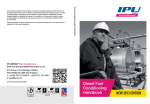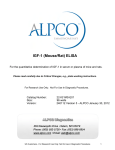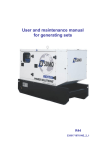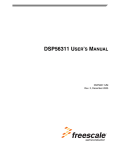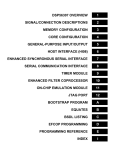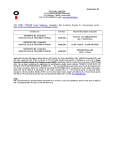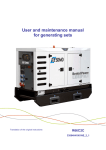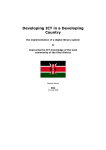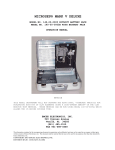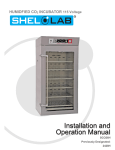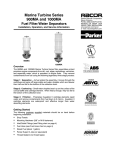Download Diesel Fuel Conditioning Handbook 2013 EDITION
Transcript
Diesel Fuel Conditioning Handbook 2013 EDITION Welcome Diesel engine and fuel system technology continue to evolve at a rapid rate, driven by the desires to improve performance, efficiency and reliability and to reduce harmful emissions. Global pressure on fuel supply, coupled with the search for environmentally friendly fuel sources, means that biodiesel is becoming more and more common in the supply chain. Diesel engines are now especially sensitive to even the slightest fuel contamination, while the latest specifications of diesel fuel are more prone to spoilage and becoming contaminated. Both factors work together to make the life of those storing, and using, diesel more difficult. This handbook has been written to help diesel fuel users, like you, understand some of the issues associated with modern day diesel fuel, its storage and use. We outline some of the common forms of diesel contamination and their causes and, of course, provide you a full suite of solutions. Whilst this guide is aimed at UK fuel users, much of the information and suggestions on good fuel husbandry are universal. 2 Index Page Fuel legislation 4-7 Why is clean, dry diesel fuel important? 8-9 What is clean, dry fuel? The ISO cleanliness code 9 10-11 Biodiesel12-13 Diesel contamination types 14-17 Preventing fuel contamination 18-19 Fuel company advice 20-23 Engine company advice 24-25 IPU fuel conditioning solutions 26-36 In conclusion 37 FAQs38-39 Glossary40-41 Appendix42-43 3 Fuel legislation January 1st 2011 saw the introduction of EU Directive 2009/30/EC. This directive introduced a requirement that all ‘gas oil’ (known in the UK as ‘red diesel’) for use in ‘non-road mobile machinery’ (or NRMM) and recreational craft, contains no more than 10 milligrams of sulphur per kilogram of fuel. NRMM includes tractors, harvesters and other agricultural equipment, forestry equipment, construction equipment, portable pumps and generators, forklifts, railway engines and inland waterway vessels. The introduction date for the use of this fuel in railway vehicles was delayed until 1st January 2012. The reason for moving to low sulphur fuel is to ensure that emissions control systems fitted to new equipment will function reliably. Sulphur is damaging to these systems and engines to Euro 5 standard, or above, are required to use fuel with sulphur content no greater than 10 mg/kg. This fuel is often known as Ultra Low Sulphur Diesel, or ULSD. Before the new fuel legislation, two diesel grades were generally available for non-marine use; road diesel and gas oil (used for off road equipment, coastal shipping, commercial heating equipment and stationary equipment). Road diesel was already in ULSD form but ‘gas oil’ contained up to 1000 mg/kg of sulphur. For ease of supply, in most cases, the oil industry are supplying ULS ‘gas oil’ (or ‘red diesel’) by adding a red excise marker to their road diesel supply. Because road diesel (white diesel or DERV) contains up to 7% biodiesel content, much ‘gas oil’ for NRMM now also contains up to 7% biodiesel. 4 5 Fuel legislation For reasons explained later, biodiesel and blends of diesel containing biodiesel are more prone to contamination from water and solid particulate. This potential contamination, if not properly managed, poses problems for users and operators of diesel engines – especially those with high pressure common rail injection systems. To avoid engine and fuel system damage, stored fuel needs to be kept ‘clean and dry’. The current UK diesel or gas oil specifications are: BS EN 590:2009 – Road diesel, as available from nationwide forecourts. Un-dyed with up to 7% bio-content. BS 2869:2010 Class A2 – Gas oil for NRMM. Up to 7% biodiesel content and with red excise marker added. BS 2869:2010 Class D – Middle Distillate gas oil for stationary engines. Up to 7% biodiesel content and red excise marker. BS ISO 8217 – Marine Gas Oil for sea going vessels. No biocontent permissible. Copies of these fuel specifications may be found in Appendix 1. 6 Fuel legislation There are a number of Marine Residual Fuel Oils that are not covered by the scope of this document. For clarity regarding the definition of ‘sea going vessels’: Inland waterway vessels (non sea going) are those defined by the Maritime and Coastguard Agency (MCA) categories A, B and C. Category A: Narrow rivers and canals where the depth of water is generally less than 1.5 metres (Corresponding to EU inland waterway zone 4). Category B: Wider rivers and canals where the depth of water is generally more than 1.5 metres and where the significant wave height could not be expected to exceed 0.6 metres at any time (EU inland waterway zone 3). Category C: Tidal rivers and estuaries and large, deep lakes and lochs where the significant wave height could not be expected to exceed 1.2 metres at any time (EU inland waterway zone 2). Any recreational craft outside of these areas and ‘going to sea’ may still use existing high sulphur diesel (BS ISO 8217), ‘go to sea’ means to operate seaward of categories A, B & C. We should point out at this stage that, while some fuel specs allow for ‘up to 7% biodiesel’, this does not mean that it must contain biodiesel, merely that it can do. Certainly some fuel suppliers are saying that they will be able to supply bio-free ULSD for the foreseeable future, however our recent experience is that many fuel wholesalers are unable to say for certain that their fuel does, or doesn’t, contain biodiesel. ! Our advice is to assume that your diesel fuel does have bio content and treat it accordingly. Many of the problems of fuel contamination addressed in the booklet will just as easily occur in pure petro-diesel and it’s always better to be safe than sorry! 7 Why is clean, dry diesel fuel important? To meet today’s demanding performance, emissions and fuel economy requirements, the latest generation of diesel engines use advanced electronic fuel injection systems with injection pressures in excess of 35000 psi – 10 years ago injection pressures rarely exceeded 3000 psi. With injector nozzle openings as small as 2-3 μm, they are designed to deliver a precise quantity of fuel, in a well defined spray pattern with an injection cycle lasting around .005 second. Product reliability expectations are also high and diesel fuel injectors are required to operate for up to 10000 hours, this equates to around half a billion operations. To achieve this clean fuel is vital. Even when microscopic particles are present in fuel, these very high injection pressures can cause accelerated wear to fuel system components. Particle contamination of diesel fuel will lead to abrasive wear of the injectors and pump 8 valve, this will result in pressure leakage which will, in turn, lead to poor fuel delivery and engine performance problems. The effects of water in diesel fuel can be severe; it can corrode metal components, it can help to concentrate acids that accelerate corrosion, it can react with certain additives, it can reduce fuel lubricity – which can cause seizing of close tolerance assemblies, and it can cause explosive damage to fuel injector tips as the water becomes super-heated during the combustion process. Where water is present in storage tanks it can promote the growth of ‘diesel bug’ and can also accelerate fuel oxidation. What is clean, dry fuel? Clean, dry diesel is fuel that has no free or emulsified water and has low levels of dissolved water and solid contaminants. For engines designed to achieve Euro 2, 3, 4 and 5 emissions standards and above the Worldwide Fuel Charter specifies a maximum dissolved water content of 200ppm and a particulate cleanliness level of 18/16/13, as defined by ISO 4406:1999. However some engine manufacturers are now requiring a fuel cleanliness level of 12/9/6 for use in engines with the latest High Pressure Common Rail (HPCR) systems. 9 The ISO cleanliness code The ISO standard ISO 4406:1999 is the internationally recognised method of quoting the solid particulate count in a fuel sample. The code is made up of three numbers that identify the number of particles that are present in one millilitre of fuel: As an example the code is typically quoted: 18/16/13 18 refers to particles greater than 4 micron 16 refers to particles greater than 6 micron 13 refers to particles greater than 14 micron To give an idea of scale: Grain of Salt = 100 micron Human Hair = 70 micron Lower limit of visibility (naked eye) = 40 micron Bacteria = 10 micron Therefore, in the example quoted above – 18/16/13 10 Range number Micron size Particle count range 18 4+ 1300-2500 16 6+ 320-640 13 14+ 40-80 ISO 4406:1999 Particle count per millilitre of fuel >28 Greater than 2500000 Up to and including – 28 1300000 2500000 27 640000 1300000 26 320000 640000 25 160000 320000 24 80000 160000 23 40000 80000 22 20000 40000 21 10000 20000 20 5000 10000 19 2500 5000 18 1300 2500 17 640 1300 16 320 640 15 160 320 14 80 160 13 40 80 12 20 40 11 10 20 10 5 10 9 2.5 5 8 1.3 2.5 7 0.64 1.3 6 0.32 0.64 5 0.16 0.32 4 0.08 0.16 3 0.04 0.08 2 0.02 0.04 1 0.01 0.02 0 0.0 0.01 11 Biodiesel Biodiesel is nothing new. Rudolf Diesel, the inventor of the diesel engine, tested peanut oil fuels in his engines and vegetable oils were widely used during World War Two as a petro-diesel substitute. What is new, is the way that various different plant substances can now be converted to diesel on an industrial scale, with sources including soybean, palm, jatropha, hemp, rape and coconut oils widely used. Some facilities have even been set up to convert waste animal fats to biodiesel and a great deal of research is being done into the production of diesel from forms of algae and fungi. The most common form of biodiesel is Fatty Acid Methyl Ester (FAME) and it is this that is now added to petro-diesel to form the blends used throughout the world. These are normally identified by the ‘B Factor’; B100 being pure biodiesel, B20 being a blend of 20% biodiesel/80% petro-diesel, B5 being a blend of 5% bio/95% petro and so on. 12 The properties of biodiesel are different to those of petro-diesel. Biodiesel contains more water than petro-diesel, it is introduced during the manufacturing process, and biodiesel is more hygroscopic – it absorbs water from the atmosphere. Typically petro-diesel fuel can only absorb about 50 parts per million (ppm) of dissolved water while biodiesel can absorb as much as 1500 ppm. This water absorption tends to occur at higher ambient temperatures and, as the temperature drops, the water can precipitate out from the fuel, first forming a water-in-fuel emulsion before finally falling to the bottom of the fuel tank as free water; here it can cause serious problems of contamination. Most global fuel standards recommend a maximum water content of 200 ppm. Biodiesel has superior lubricity to that of petro-diesel and its lubricating properties are one of the reasons it is added to low sulphur diesel. It also has poorer low temperature performance; this should not be an issue as low temperature additives are added to commercially available fuel, although there were widespread reports of diesel waxing during the winter of 2010/2011. 13 Diesel contamination types Diesel fuel can contain many types of contaminant, all of them harmful to fuel or engine systems to some degree. Water – The most concerning fuel contaminant. It can be present in fuels in dissolved, emulsified and free states. Dissolved water – Water that is chemically dissolved, or absorbed, into fuel and distributed molecule by molecule. Just like sugar in tea. Emulsified water – Where very small droplets of water are suspended in the fuel. Just like oil and vinegar in a salad dressing. Free water – Water that falls out of suspension in the fuel and gathers at the bottom of the fuel tank. Whilst dissolved water can affect fuel stability, it is free and emulsified water that are more problematic. Not only can it cause fuel system and engine damage but it also promotes microbial growth in fuel systems. Being heavier than diesel, water tends to fall to the bottom of a fuel tank. Where sufficient water gathers in the fuel tank, it will form a layer at the tank bottom between the stored fuel and the tank surface. This is known as ‘bottom water’ or the ‘water phase’ and this is where ‘diesel bug’ growth will occur. Diesel bug – Microbial growth within a fuel tank or system is commonly known by the generic term ‘diesel bug’. Diesel bug isn’t a single type of organism, there are up to 100 different types of bacteria, moulds and yeasts that have been found inhabiting fuel systems. The microbes can exist in the fuel tank in planktonic form (free floating in the fuel or water phase) or in a biofilm (more of which later). Microbe types: 14 Bacteria – Single cells, typically 1-10 micron in size, 20-30 minute generation time (the time for the population to double), one cell can multiply into 2 million in 7 hours. Bacteria will degrade fuel over time. Mould – Type of fungi, long multi-cellular filaments. There is little indication that they degrade fuel but, due to the long strands, are effective at blocking filters etc. Yeast – Type of fungi, relatively slow growing. Typically 3-4 micron in size. Sulphur is poisonous to the microbes that can grow in fuel, as a result ‘diesel bug’ was rarely a problem with most diesel storage tanks. However, following the switch to ULSD, these microbes can exist happily anywhere within the fuel tank; however they thrive wherever there is an interface between fuel and water – most commonly at the tank bottom. Here microbes will live and multiply in the water phase, whilst drawings nutrients, in the form of hydrocarbons, from the fuel phase. Often a visible layer of microbial growth will be visible at the fuel/water interface, this is often known as a ‘rag layer’. The microbial growth found in fuel is sometimes referred to as ‘algae’. This is a misnomer, algae needs sunlight to grow – something that’s usually in short supply in a fuel tank. The level of microbial contamination in a fuel system is hard to predict as every system is different and offers a unique environment. However where serious contamination occurs it is likely that a biofilm will have formed within the fuel tank. 15 Diesel contamination types Biofilms – A biofilm is a complex structure of microbes in which cells adhere to the walls of the fuel tank and to each other. It begins to form when free floating microbes land on a surface and attach themselves to it. This attachment is initially reversible, although if they are not removed they start to change their structure and become irreversibly attached to the surface. These microbes then start to divide and attract other microbes to join the colony. Biofilms, given time, can grow to millimeters thick and contain billions of microbes. These microbes adapt their behavior within the biofilm in order to support the colony: some will produce protective slime, some will lay dormant waiting for conditions to change, and some will simply multiply. Periodically, perhaps following fuel tank turbulence, chunks of the biofilm will slough off, this gives the microbes the opportunity to colonise other areas of the fuel system, and this can be particularly problematic as large pieces of bio-mass will easily block a fuel filter. Live microbes settling on a filter could also start the formation of a biofilm, a possible problem where the filter is only used intermittently. Another problem caused by biofilm formation is that they can excrete acid, this acid will erode a metal fuel tank quite easily and many holed tanks are as a result of biofilm formation. It can take a biofilm within a fuel system 1 to 3 months to mature and it is generally considered that around 99% of biomass within fuel systems can be found in biofilms – which also contain around 90% water. Asphaltines – These are present in all petro-diesel fuel to a greater or lesser extent, although they tend to increase with changes to fuel temperature and fuel oxidation. They are hard, brittle particles that are not soluble in fuel, and are generally less than 2 microns in size making them harmless to the fuel injection system. However they can agglomerate into larger particles which can easily block 16 Diesel contamination types engine filters. These particles tend to collect at the bottom of a fuel tank and can form an oily sludge that is often confused with microbial contamination. Gums and other organic contaminants – The oxidation stability of biodiesel is inferior to that of petro-diesel. Meaning that, as the fuel comes into contact with oxygen chemical reactions break down the fuel into peroxide, organic acids and gummy sediment. These soft, sticky substances can stick to fuel filters and engine components and cause acid erosion. Wax – Wax crystals can form in diesel fuel as a result of low temperatures. In modern diesels this is rarely a problem although in ultra low sulphur biodiesel blends the wax solubility is lower and this can promote wax formation. Other particles – Other particles can be present in fuel with diverse sources such as road dust and grit, soot, fuel tank rust and engine wear particles. All particles, regardless of source have the potential to cause wear or damage to the fuel injection system or engine. Sludge – It is often claimed that ‘sludge’ is found within diesel fuel systems, and it is often interpreted as being one of the above contaminants. In reality it is likely that it is formed from a combination of many of the above contaminants and care should be taken, and a proper diagnostic process should be followed, when recommending a solution to the problem. Bio-Diesel Effects – Due to its aggressive solvent properties, when bio-diesel is used in a fuel system for the first time it can have the effect of loosening deposits from fuel tanks and lines. This can result in clogged filters soon after a change to bio-diesel. This same solvent effect can also cause degradation of rubber seals and gaskets in the fuel system – this is usually only a problem on engines manufactured before 1990. 17 Preventing fuel contamination As with many problems, prevention is better than cure. The key to maintaining fuel quality and preventing fuel contamination problems, and thereby avoid expensive engine damage and equipment downtime, is good housekeeping. Good fuel housekeeping is a combination of effective processes, a little technology and some good old fashioned common sense. We recommend the following measures: •Where possible purchase your diesel fuel from reliable sources to known specifications •Ensure all tanks are in good condition, leak free and well maintained •Avoid fuel contact with copper and zinc containing metals as they promote oxidation •Always follow recommended methods when refilling tanks to avoid the accidental introduction of contamination •Where possible, keep fuel cool to minimize water absorption •Keep fuel tanks as full as possible to reduce possible water condensation from moisture laden air •Use tank drains to periodically remove tank bottom water and sediment •Employ an ‘on tank’ filtration (or fuel polishing) system to remove water and other contamination •Filter fuel every time it is moved – this is considered to be ‘best practice’ as fuel is at most risk from contamination when it is being transferred 18 •If storing fuel in multiple tanks, employ a rotation system to use oldest fuel first •Consider the use of a fuel additive to maintain fuel stability and a fuel biocide to minimize microbial growth •Introduce a regular test program to check fuel for water, particulate and microbial growth •Where you are unable to guarantee the quality of the fuel being used in your plant, mobile gensets etc, appropriate fuel conditioning equipment should be fitted onto the engine or appropriate filtering measures should be employed when re-fuelling •Ensure that all appropriate staff are trained in the importance of good fuel housekeeping and that processes and procedures are in place to minimize the possibility of accidental fuel contamination. You will see over the following pages, that much of this advice is echoed by the major fuel companies and engine manufacturers. With today’s modern high tolerance diesel engine technology, diesel fuel should be considered a vital component of the engine and should be looked after accordingly. 19 Fuel company advice Potential problems with fuel condition and contamination are recognised by major fuel companies. They place the responsibility on the fuel user for maintaining fuel cleanliness. Some examples of their advice to maintain fuel quality: BP Recommend the following measures to extend the storage life of fuel: •Establish a regular fuel maintenance program to ensure that water and dirt is removed from storage tanks. This will also remove any chance for fungus to grow. •Establish a system for filtering the contents of the main storage tank through a recirculating filter system. This can be made automatic and will reduce the potential for problems by removing sediment and gums. The filters should be checked and changed at regular intervals. When the filter change interval reaches a certain frequency then the fuel should be changed over. •Establish a monitoring program whereby samples are taken at regular intervals to monitor the condition of the fuel. The samples can be examined at the site for evidence of haziness, sediment, darkening or sent to a laboratory for testing. Quoted from BP News – ‘Long Term Storage of Diesel’ 20 21 Fuel company advice Chevron/Texaco State the following precautions should be taken for long term fuel storage: •Purchase clean, dry fuel from a reputable supplier and keep the stored fuel cool and dry. The presence of free water encourages the corrosion of metal storage tanks and provides the medium for microbial growth. •Add an appropriate stabilizer that contains antioxidant, biocide and corrosion inhibitor. •Use a fuel quality management service to regularly test the fuel, and, as necessary, polish it – by filtration through portable filters – and add a fresh stabilizer. This is common practise for nuclear power plants with backup diesel powered generators. •Install a dedicated fuel quality management system that automatically tests and purifies the fuel and injects fresh stabilizer. Quoted from ‘Chevron Diesel Fuels Technical Review’ Exxon/Mobil Advise the following in relation to fuel storage: • How long can I store diesel fuel? If you keep it clean, cool and dry, diesel fuel can be stored 6 months to 1 year without significant quality degradation. Storage for longer periods can be accomplished through use of periodic filtrations and addition of fuel stabilizers and biocides. Quoted from Exxon/Mobil Website – http://www.exxon.com/USA-English/GFM/fuels_quality_diesel_faq.aspx 22 Fuel company advice 23 Engine company advice Engine and vehicle manufacturing companies acknowledge the damage that contaminated fuel can cause to their engines. However any failures are generally held to be the responsibility of the user and warranty claims associated with dirty fuel will be rejected. Here is some of their advice on keeping fuel clean: Cummins With regard to the fuel cleanliness requirements of modern HPCR systems: Contamination levels vary widely as a function of location, time and fuel handling practices. While the Worldwide Fuel Charter establishes a target for supply fuel cleanliness, there is no assurance that the 18/16/13 target will be maintained. Filtration is only one part of a total contamination control program. Anytime fuel is stored, pumped or transferred, there is a risk of introducing, creating, or dislodging contamination into the fuel. Effective programs address fuel source, storage and handling issues. Good contamination control practices include, but are not limited to: •Consistently obtaining in-spec fuel from reliable, dependable sources, •The use of filters and fuel water separators for storage and day tanks, •Routine tank cleaning, •Steps to ensure that biological growth does not get started, •Clean fuel transfer operations, and •Appropriate on-board filtration and water removal. 24 Often, raising the awareness of service personnel and operators with regards to contamination control is one of the most effective contamination control measures that can be taken. Quoted from the Cummins Inc white paper “Filtration Solutions for High Pressure Common Rail Fuel Systems” Caterpillar On the consequences of water and solid contaminants in diesel fuel and their suggested solutions: Water in fuel An excessive amount of latent water in the fuel is a key cause of injector failure. Water has inadequate film strength to prevent metal-to-metal contact between the plunger and the barrel, resulting in plunger scuffing or seizure. Water can be effectively removed by the use and regular maintenance of a water separator or bulk fuel filter/water coalescer. Removal of latent water is essential to prevent scuffing with the upcoming injection pressure increases and subsequent hydraulic loading of internal injector parts. Solution: Proper maintenance of fuel tank drains, water separators and/or use of a bulk fuel filter/coalescer. Abrasive contaminants Increased injection pressure acting on the same level as abrasive contaminants in the fuel results in accelerated injector abrasive wear. This abrasive wear cannot be eliminated through the use of improved materials and processes. Abrasive wear can only be reduced be removing abrasives from the fuel. Solution: Single or series High Efficiency fuel filters and/or bulk fuel filter/water coalescer. Quoted from ‘Caterpillar Fuel System (Fourth Edition)’ 25 IPU fuel conditioning solutions The following products and services are all available from IPU and can help you to maintain your fuel quality and avoid expensive breakdowns and repair. Sampling Best practise for fuel testing is to allow fuel to settle over a period of 24 hours then to sample fuel at the top, middle and bottom of the tank. In practice, a tank bottom sample can normally reveal the extent of contamination within a tank and so top/middle/bottom testing should only be needed on safety critical applications. Tank bottom samples can be taken from drain points if they are fitted, where they are not, or to sample higher in the tank, we recommend the ‘Bacon Bomb’ sampler. The Bacon Bomb is lowered into the tank on a cord, when it contacts with the tank bottom, a plunger opens to admit a sample of the fuel. As the Bacon Bomb is withdrawn the plunger seals tight retaining the sampled fuel. The suction action of the Bacon Bomb ensures that any water, microbial growth and sediment on the tank bottom are captured within the fuel sample. A second cord can be attached to the Bacon Bomb to open the plunger for sampling at points above the tank bottom. 26 The Bacon Bomb Bacon Bombs, which are manufactured in stainless steel or brass, to reduce the risk of sparking, are available from IPU in sizes from 4oz (118ml) to 32oz (946ml). For fuel tanks that are more difficult to access, moulded vehicle fuel tanks for example, a ‘fuel thief’ is more suitable for fuel sampling. IPU can supply a range of flexible fuel thieves suitable for just about any application. Testing There are number of fuel tests available on the market, varying in cost, time taken and accuracy, but a simple, basic test can be undertaken by virtually anyone. It is known as the ‘Clear and Bright’ test. After sampling the fuel it should placed into a clean, clear glass container and simply held up to the light. As the name suggests, the fuel should appear ‘clear’ and ‘bright’, meaning that no particles, debris or cloudiness should be evident in the fuel. If any of these things are evident, it is a sign of contaminated fuel. Of course, it is good practise to carry out further testing to establish if there is any contamination present that is not detectable to the human eye or to establish the true nature of any visible matter in the fuel. The IPU fuel experts are able to carry out initial tests on your premises ‘tank side’ and can give your results in minutes. We recommend, and can provide, the following tank side tests to give a fast indication of whether your fuel is ‘clean and dry’: 27 IPU fuel conditioning solutions Water – Tank bottom water is usually visible and can be detected with the ‘clear and bright’ test. However it can also be detected in the tank using ‘Water Finding Paste’. The paste is simply attached to a rod which is inserted into the fuel tank and pushed to the tank bottom. If there is water present the paste will change colour upon contact with it. Diesel bug – Most diesel bug tests take days to give results. At IPU we use a technique called ‘ATP Testing’ which will give an indication of microbial presence in fuel in minutes. ATP stands for Adenosine Triphosphate which is a molecule present in, or around, all living things. By measuring the level of ATP present in a fuel sample, we can gauge the level of microbial activity in the fuel. We follow a short process with the fuel sample, swab it, and then insert the swab into a luminometer which gives a reading that indicates the level of fuel bug contamination. 28 IPU fuel conditioning solutions ! Please note that, regardless of the diesel bug test method you intend to use, samples should always be taken and stored in clean, sterile containers to prevent false reading from background contamination. Particles – As we have previously outlined, diesel fuel needs to be maintained to an ISO particle code to minimise fuel system wear and ensure engine reliability. Using our portable particle counter, we can measure the cleanliness of your fuel, on your premises within minutes. We simply run a small sample of diesel through the counter and then give you a precise reading to ISO 4406 (or NAS code). By using ‘tank side’ testing, we can provide you with virtually instant test results which can then be used to identify an appropriate course of preventative, or remedial action. There may be instances where tank side testing is not enough, for example where more sophisticated tests are required or where laboratory standard results are required. With this in mind, we are also able to offer the IPU Fuel Testing Service. IPU fuel testing service We are able to offer the following accredited (where applicable) laboratory standard tests on your diesel fuel: •Particle Assessment to ISO4406 or NAS code •Karl Fischer Water Content Testing to IP438 •Total Viable Count Microbe Testing to IP385/99 •Spectrographic Testing for Metals Content (based on ASTM D5185) •Bio Diesel (FAME) Content in Diesel Dependent upon tests required, turnaround time can be as low as 24 hours from receipt of sample. We can also carry out other fuel tests should you require them and will provide complete interpretation of results and advise on possible remedial actions. 29 IPU fuel conditioning solutions Preserving stored fuel quality Tank Vent Filtration – Even with good fuel housekeeping procedures, water and particle contamination can find their way into storage tanks through inadequately sealed tank breathers. Moisture laden air can cause condensation inside the tank and dust and other wear particles can easily gain access. By fitting a good quality tank breather filter you can reduce the risk of water contamination of your fuel. Fuel polishing – To ensure that your stored fuel remains ‘clean and dry’ and within fuel specifications, we recommend the use of fixed ‘Fuel Polishing Systems’ on each fuel tank. ‘Fuel Polishing’ is the constant recirculation of fuel through a series of filters, to remove particles, and coalescers, to remove water, ensuring that fuel quality is maintained. IPU Diesel Defence fuel polishing There is a Diesel Defence Fuel Polishing system suitable for any type of diesel storage tank and we can offer you a variety of filtration levels to suit your specific applications. All units are designed to operate ‘stand alone’ with 24 hour, 7 day digital timers, making them ideal for unmanned facilities containing critical standby generators or fire pumps. A variety of different alarms and automatic functions are available as standard, or options, and each model is available as either plate mounted or in a secure, IP65, vented cabinet. Tank sizes up to 500000 litres are covered by a current range, although we could bespoke design larger systems to suit your needs, and our fuel conditioning experts will recommend a running cycle to ensure that your fuel remains in optimum condition at all times. 30 IPU fuel conditioning solutions While a fuel polishing unit will remove virtually all water and damaging particulate, we recommend that a fuel biocide is also used for long term storage of diesel fuel. Diesel biocide – Fuel biocide can be used to prevent a microbial contamination becoming established or to kill an existing tank infection (sometimes known as ‘shock dosing’). It is important, when using a fuel biocide of any brand, to follow dosing instructions carefully. Whilst adding too much biocide will do nothing other than waste money, adding too little can result in a failure to totally kill the microbes within the tank, in some cases this can promote the growth of biocide resistant microbes. In the event of this happening, we recommend dosing the tank with a biocide containing a different active ingredient. Predator 8000 fuel biocide This is a broad spectrum fuel biocide suitable for preventative and shock dosing of any diesel fuel. The active ingredients are 2-methyl-4-isothiazolin-3one and 5-chloro-2-methyl-4-isothiazolin-3-one. ! Fuel biocides can be used to treat an existing tank infection and will kill any light biofilm that has formed within a tank. However, where a mature biofilm is established, at present the only truly effective way of removing a biofilm is through abrasion. This generally means that someone has to access the interior of the tank and scrub or jet wash it from the tank surfaces. Biocides can be ineffective against heavy biofilms as the chemicals are not able to penetrate through the layers of cells. It will kill the outer layers of microbes, but they can act as a protective barrier meaning the biocide cannot reach the lower levels of microbes. In these cases biocide resistant bugs can be formed. Finally, always fully filter, or polish, the fuel following a shock dose of biocide as chunks of dead biomass could have been released into the fuel. 31 IPU fuel conditioning solutions Tank cleaning – Tank cleaning is an essential part of a fuel maintenance programme. Diesel that has been stored for extended periods or in hostile environments can be so contaminated it would overwhelm a polishing system. Just as you wouldn’t wax a dirty car, we don’t polish dirty fuel. Tank cleaning does not require an uplift of stored diesel nor does it require a man to enter the toxic interior of the tank. IPU’s ClearTank service cleans the tank by filtering the fuel externally and uses cleansing agents to remove biofilms. It’s safe, economical and discrete. Protecting your equipment against bad fuel It’s not always possible to ensure that the diesel going into your equipment is to the correct specification or of good quality. You could be manufacturing machines to go into markets with variable fuel, or you could be a contractor who has to use fuel supplied to you on site. In such situations it is wise to consider measures that will protect sensitive fuel systems from dirty fuel. Most modern diesel engines will have fine engine fuel filters but these can easily be overwhelmed by fuel borne contamination. By fitting additional layers of filtration, you can provide yourself with a little insurance. Racor turbine series filters – Will protect engines against water and particle contamination using a patented three stage process: Separation – The turbine centrifuge separates solids and free water through a centrifugal action. 32 IPU fuel conditioning solutions Coalescing – Smaller water droplets coalesce on the specially designed conical baffle and are captured in the collection bowl. Filtration – The Aquabloc water repelling filter media filters out particles to a micron rating of 2, 10 or 30 micron. Racor spin-on series filters – A range of filters designed to fit into cramped engine bays. All feature replaceable filter canisters utilising Racor Aquabloc filter media which effectively removes water and solid contamination. Micron options of 2, 10 and 30 are available. The IPU Fuel Purifiner – When used in conjunction with a Racor Turbine or Spin-On filter, the Fuel Purifiner (FP) acts as a ‘first line of defence’ to remove slugs of water, dirt, sludge and grit. As the fuel enters the unit, baffles introduce a swirling action that separates water and particles from the diesel fuel. The contaminants sink to the base of the unit where they are retained, ready to be released via the drain tap. The FP will remove contamination and offer protection against even the dirtiest fuel. 33 IPU fuel conditioning solutions Mobile fuel conditioning equipment IPU also provides a selection of mobile fuel conditioning products that ensure that you can have clean fuel when you are ‘out on location’. The IPU Fuel Polishing Buggies – Are lightweight, mobile units designed for the cleaning of diesel fuel being held in fuel tanks, bowsers or drums. They use fuel filter/separators to remove particles and water contamination from diesel fuel. The fuel is pumped from the tank, filtered down to 2 micron (depending upon model), with 99% of water removal, and then returned to the tank. A number of filter elements are available, including re-usable, washable stainless steel mesh elements on some models. Fuel filter funnels – The perfect solution for those who need to refuel mobile equipment from jerry can, bowsers etc. The filter funnel works as a conventional funnel but it contains a Teflon mesh filter which prevents the passage of water and solid particles. Available in flow rates up to 15 gallons per minute, the filter funnel is ideal for clean refuelling of applications such as mowers, boats, generators etc. 34 IPU fuel conditioning solutions 35 36 In conclusion In relatively recent years, diesel engine technology was very different from what we see rolling off production lines today. It was accepted wisdom that you could pour just about anything into a diesel engine fuel tank as the engine would just chug away regardless. Thanks to global emissions legislation, the drive for improved performance and efficiency and the increase in the use of biodiesel, we all have to take a very different approach now. All diesel fuel users need to consider their fuel a vital component of their engine, and it needs to be kept in optimum condition. As we have discussed, modern engines are particularly sensitive to fuel contamination and good fuel housekeeping is essential to maintaining your fuel quality. The main consideration when it comes to your fuel housekeeping is ensuring that water is eliminated entirely from the fuel system; this prevents fuel system damage and will prevent fuel spoiling. Drawing on the advice of the major fuel companies and engine manufacturers we recommend, as a minimum, the use of fuel polishing and additives for stored fuel and the introduction of robust fuel management procedures, including a fuel testing regime. If you would like any advice, or further information, on how IPU can help you with your diesel conditioning, call us today 0121 511 0400 or email [email protected] 37 FAQs How long can diesel fuel be stored for? There are examples of diesel fuel being stored for many decades without serious degradation; however where diesel fuel has a bio content this will no longer be possible. If fuel containing FAME is kept clean, dry and cool, it can be stored for 6 months to 1 year without significant quality degradation. Longer term storage can be achieved through the use of fuel polishing and the addition of fuel stabilizers and biocides. What is fuel polishing? Fuel polishing is the process of removing water and particulates from fuel to bring it back in line with fuel specifications. Ideally fuel should have an ISO particle code of 18/16/13 and a dissolved water content no greater than 200 parts per million. There should be no free or emulsified water present. How often should fuel be polished? If you have standing fuel, and if no ‘on tank’ fuel polishing system is fitted, then it’s recommended that fuel should be polished every 6 months. When doing so, where fuel is being drawn from and returned to the same tank the entire volume of the fuel should be run through the polishing system 4 or 5 times to ensure that all contamination is removed. If transferring fuel to another holding tank, one pass through the polishing system is sufficient. Can petrol be added to diesel to kill ‘diesel bug’? Petrol is poisonous to the microbes that can grow in a fuel tank and it will kill them or prevent them from growing. However, the lubricity of petrol is inferior to that of diesel and there is a serious risk of fuel system damage as a result of mixing petrol into diesel. We strongly recommend that you use only a specially formulated fuel biocide to kill diesel bug. 38 Will fuel polishing remove all fuel tank contamination? Fuel polishing will remove free and emulsified water as well as solid particles (size dependent upon the filter element being used). If there is microbial contamination in the tank any free floating biomass will be removed. However, if the tank is badly contaminated and a bio-film has formed – a bio-film is a colony of microbes that have adhered to the tank surfaces – fuel polishing may be only partially effective. In such instances tank cleaning will be required. Can fuel colour affect its performance? Diesel fuel colours are naturally variable due to the crude oil sources, the refining methods and, of course, dyes are sometimes added as an excise marker. Slight colour variation is no indication of fuel properties. However, in some cases, where fuel has been stored for long periods of time, it can darken due to fuel oxidation or contamination, this could cause engine performance issues. Can Algae be found in fuel tanks? Generally no. Algae is a plant which relies on sunlight for growth. Algae is often, incorrectly, used to describe diesel bug. Are magnets a reliable way to treat fuel problems? There is very little hard, trustworthy data supporting the claims that magnets treat any form of fuel contamination. Some were originally introduced claiming that they “killed diesel bug”, others were developed to alter the molecular make up fuel. Other than anecdotal evidence we have yet to see a study that proves these claims. What we do know is that a study by the Australian Department of Defence found that a particular brand of fuel magnet had no discernible effect on diesel bug and other contaminants, and actually introduced more contamination into the fuel as the magnets eroded. From our own experience we also know that, where fuel deliveries have high quantities of iron – which can be common, – magnets can actually induce filter and fuel system blockage by causing iron particles to agglomerate together. 39 Glossary Ash content – A measure of the quantity of metals contained within the fuel. Large concentrations of metals may cause injector plugging, deposits within the combustion chamber and fuel system erosion. Cetane index – Is an estimation of the base cetane number derived by a calculation using the distillation range and density of the fuel. There are various methods of calculating cetane index but it is rarely used as a measure as it does not take fuel additives and their performance enhancements into account. Cetane number – Is a measure of the fuels ignition delay; the time between the start of the injection cycle and the start of combustion. The higher the cetane number the shorter the ignition delay. Diesel engines generally run best with a cetane number between 40 and 55, with higher speed diesel engines functioning more efficiently with higher cetane numbers. There is generally no benefit from raising cetane number beyond 55. Cloud point – The temperature at which wax starts to solidify within the diesel fuel. This is another indicator of low temperature performance. Cold filter plugging point – The lowest temperature at which a defined volume of diesel fuel will pass through a specified filter element in specified time period. This measure gives an estimate of the lowest temperature at which the fuel will give trouble free operation. Copper corrosion test – A standard test to identify the corrosive properties of diesel fuel. 40 DERV – Also known as ‘road diesel’. Standard, full excise duty diesel fuel without red excise marker. Stands for Diesel Engine Road Vehicle. Flash point – The lowest temperature at which a flammable liquid will form a vapour to create an ignitable mixture with air. HPCR – High Pressure Common Rail. Micro carbon residue – The carbon residue value is used to give an indication of the combustibility of a fuel and its likelihood of forming carbon deposits. NRMM – Non-Road Mobile Machinery. Polycyclic aromatic hydrocarbons – The organic pollutants contained within a fuel, generally considered to be carcinogenic. ULSD – Ultra Low Sulphur Diesel. Diesel, or ‘gas oil’ containing no more than 10mg/kg of sulphur. Worldwide Fuel Charter – A document jointly released by the European Automobile Manufacturers Association (ACEA), the Alliance of Automobile Manufacturers, the Engine Manufacturers Association (AMA) and Japan Automobile Manufacturers Association (JAMA). This document seeks to match fuel specifications to the needs and capabilities of engine and vehicle technologies. 41 Appendix Diesel and gas oil specifications Property Units Appearance Limits EN590:2009 BS2869:2010 A2 BS2869:2010 D Clear and bright, free from visible sediment and water Colour 2.5 max Odour Red Test method Visual Red D1500/IP196 Merchantable Density @ 15°C kg/m³ 820-845 Viscosity @ 40°C cSt 2.0 – 4.5 Carbon residue (micro) 10% bottoms %m/m 820 min 2.0 – 5.0 EN ISO 3675 1.5 – 5.0 0.3 max EN ISO 3104 EN ISO 10370 Distillation: Recovery at 250°C % v/v 65.0 max 65.0 max 85.0 min Recovery at 350°C % v/v 85.0 min (50%) 240-340 Volume recovered °C Flash point (PMCC) °C EN ISO 3405:1998 (95%) 360 max 56 min EN 22719 Cetane number 51 min 45 min EN ISO 5119 Cetane index 46 min 45 min EN ISO 4264 8 max n/a Polycyclic aromatic hydrocarbons % wt Water content mg/kg 200 max EN ISO 12937 Particulate mg/kg 24 max EN 12662 Ash content % wt 0.01 max EN ISO 6245 Sulphur content mg/kg 10 max EN ISO 20846/20884 Copper corrosion (3h @ 50°C) Class 1 EN ISO 2160 Cold filter plugging Point °C Summer -5°C Cloud point °C Summer -3°C Summer -4°C Winter -12°C IP391:1995 EN 116 – IP 309 Winter -15°C n/a EN 23015 Winter -5°C Fatty acid methyl ester (FAME) content % v/v 7.0 max BS EN 14078 Oxidation stability mg/ 100ml 2.5 max BS EN 12205 Lubricity, corrected wear scar diameter @ 60°C micron 460 max BS2000-450 Notes: Summer = Sales from retail sites between 16th March to 15th November 42 Marine distillate fuel specifications Property Limits Units ISo 8217 DMX Appearance ISo 8217 DMA ISo 8217 DMZ ISo 8217 DMB Clear and bright, free from visible sediment and water Density @ 15°C kg/m³ Viscosity @ 40°C cSt Carbon residue (micro) 10% bottoms %m/m Flash point °C Calculated cetane index n/a 890 max 1.4–5.5 2.0-6.0 900 max 3.0–6.0 2.0-11.0 0.3 max 43 min 60 min 45 min 40 min Total sediment by hot filtration % m/m n/a Water content mg/kg n/a Acid number mgKOH/g Ash content % m/m Sulphur content % m/m Hydrogen sulphide mg/kg Pour point °C n/a Cloud point °C -16 Oxidation stability mg/100ml 2.5 max Lubricity, corrected wear scar diameter @ 60°C micron 520 max 35 min 0.1 max 300 max 0.5 max 0.01 max 1.0 max 1.5 max 2.0 max 2.0 max Summer 0°C Winter -6°C Summer 6°C Winter 0°C n/a 43 The information contained in this handbook is for general information purposes only. The information is provided by IPU Group and while we endeavour to keep the information up to date and correct, we make no representations or warranties of any kind, express or implied, about the completeness, accuracy, reliability, suitability or availability with respect to the handbook or the information, products, services, or related graphics contained therein. Any reliance you place on such information is therefore strictly at your own risk. Users should obtain fuel system information from their equipment manufacturer’s user manual or service department for their specific application. IPU GroUP Fuel Conditioning Visit our Group website www.ipu.co.uk IPU Group, Churchbridge, Oldbury West Midlands, B69 2AS England T: +44 (0) 121 511 0400 F: +44 (0) 121 511 0401 E: [email protected] © IPU Group December 2012 2003/372












































